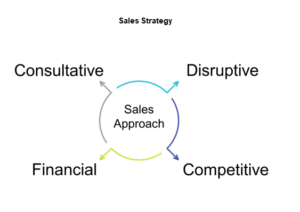Situational Agility: The Key to Unlocking Seller Success

VantagePoint has studied thousands of sales situations across dozens of industries and the research is clear: when sales teams exhibit Situational Agility they see an average of 20% more revenue per seller.
What is Situational Agility?
First things first: if you haven’t read our article on Foundational Agility, go read it here. Your Sales Team can’t work towards Situational Agility without Foundational Agility enabling it.
Now that you’re caught up, here are the components of Situational Agility:
- Assessing the key factors and making sense of the buying situation
- Choosing which sales strategy is the most likely to be effective given the buying situation you face
- Executing the tactics within that strategy and continually monitoring buyer reactions and gaining feedback
What Are the Categories of Factors in Buying Situations?
On the surface, buying situations seem immensely varied and complicated. Florida State University’s research about buying situations identified up to 25 buying factors. But training salespeople to deal with 25 separate factors is just not feasible and would lead quickly to stress and burnout. So, we knew there needed to be a simpler solution.
So, we asked how we can make sense of these buying factors in a way that sellers can execute easily.
And that led us to find that some factors almost never come up. Then we started to see patterns in the more common factors that were naturally grouped into five easily identifiable and manageable categories:
Buying Process
- The steps a buyer takes to buy a product or service, that move from identifying their problems, to establishing criteria to solve that problem, and mitigating risk before purchasing.
- Establishing what stage the buyer is at in their journey is a foundational component of sales agility and is paramount in any sales process.
Problem Awareness
- How aware is the customer of their problem?
- Copyblogger cites Advertising Guru Eugene Schwartz’s work in his classic book, Breakthrough Advertising, saying “Schwartz broke down prospect awareness into five distinct phases,” from “Completely Unaware,” to “Most Aware.”
- This is where sales enablement can really make a difference. Helping the customer fully understand their pain points and how your product can alleviate those pain points can help move the buyer along in their process.
Customer Dynamics
- How is the customer communicating and exchanging information with the seller, and vice versa?
- What levels of decision makers and personas are present and impact the needs and requirements?
- What emotions are present in the relationship between the customer and seller?
- Identifying these dynamics can help sellers be more agile because they’ll be able to anticipate and respond to customer queries and objections in the most effective way.
Solution Definition
- Clients don’t just need help identifying their problems, but also envisioning what the solution looks like.
- Helping them define solution criteria will help build trust in the seller and give both the buyer and seller a target to aim at.
Competitive Landscape
- An understanding of your buyer’s competitors and how the problems they’ve solved and products they’ve used help them to gain a competitive advantage
- Understanding your buyer’s competitive landscape will help with the problem awareness and solution definition factors in buying situations. If you can point out how a particular competitor solved a similar problem and thus has a competitive advantage, your buyer will be much more motivated to define a solution, and ultimately close a deal.
Now That I’ve Assessed the Buying Factors, How Can My Sales Efforts be Most Effective?
The next step in the Situational Agility framework is choosing the most effective Sales Pattern based on the buying factors you’ve assessed.
As our research has validated, high-performing sellers don’t display one pattern of behavior, but rather must choose based on the buying situation between the following four:

Consultative
- Underpinning all modern sales strategies is the consultative strategy. In fact, the tactics within consultative selling are highly correlated with each of the other sales strategies.
- Modern buyers want to see sellers more as partners who help them solve their problems, and less as gatekeepers standing in the way of those solutions.
- Agile sellers need to be able to guide and answer questions along the way and show a deep concern for helping the customer make the best decision for their business.
- It is through this role as consultant and guide that trust and relationships are built, and confidence is instilled. Only then can the rest of the sales strategies be used.
Financial
- Sellers need to clearly identify and effectively communicate the impact of their product to the buyer’s bottom line.
- The value must be quantified and the return on investment analyzed. The buyer requires a solid business case to justify the purchase.
Competitive
- A deep understanding of your competition is the basis of competitive selling.
- Customers are not shopping in a vacuum and will likely know a lot about not only your products but your competitors’ products. How you position your solutions in contrast to those of your competitor’s matters.
- Helping customers make sense of the various options, simplify their decision-making process, and make high-quality, low-risk decisions.
Disruptive
- This pattern of sales behaviors is all about breaking your clients out of their comfort zone and creating both awareness of and urgency to solve their problems.
- It’s also about pushing back on preconceived notions that buyer’s come into the process with and teaching them new ways to think about their problems and possible solutions by providing objective insights.
Now, with a more manageable list of factors to identify and strategies to choose from after those factors are identified, the final component of the Situational Agility framework comes into play.
How do I Help My Sellers Most Effectively Execute These Strategies?
As we went over in our article on Foundational Agility, execution is not just the enactment of a predetermined sales move, but also the follow-up moves and monitoring.
Your goal is to build a database of easily repeatable actions aligned with specific situations, so salespeople need to be trained to get feedback along every step of their process
Our AgileEdge® diagnostic can help your organization do just that by using machine learning to analyze sales and aggregate data across large numbers of deals to give salespeople highly accurate insights into what sales strategies to execute in what buying situations.
Takeaway
Situational Agility builds on Foundational Agility by allowing sales teams to more effectively respond to specific buying factors, along specific stages of the buyer’s journey, with precise sales strategies guaranteed to be most effective in a given situation.
If you can train your people to have Situational Agility, you’ll see each seller’s revenue growth, and when more of your sales team do better, rather than just a few overachievers (as we noted in this article), so does your bottom line.
VantagePoint Performance is now part of Imparta, a global leader in performance improvement for customer-facing teams.
